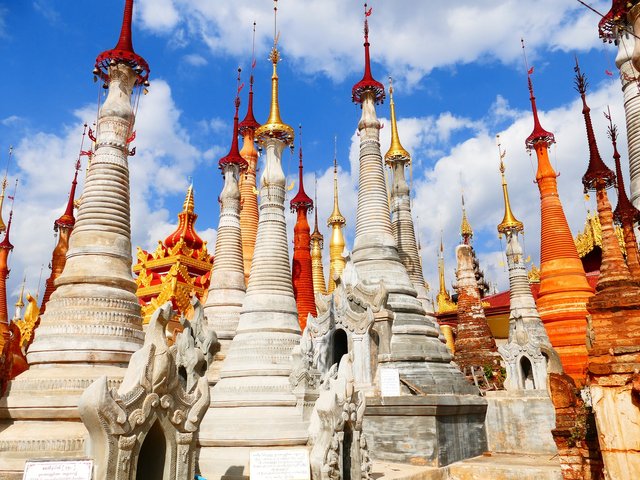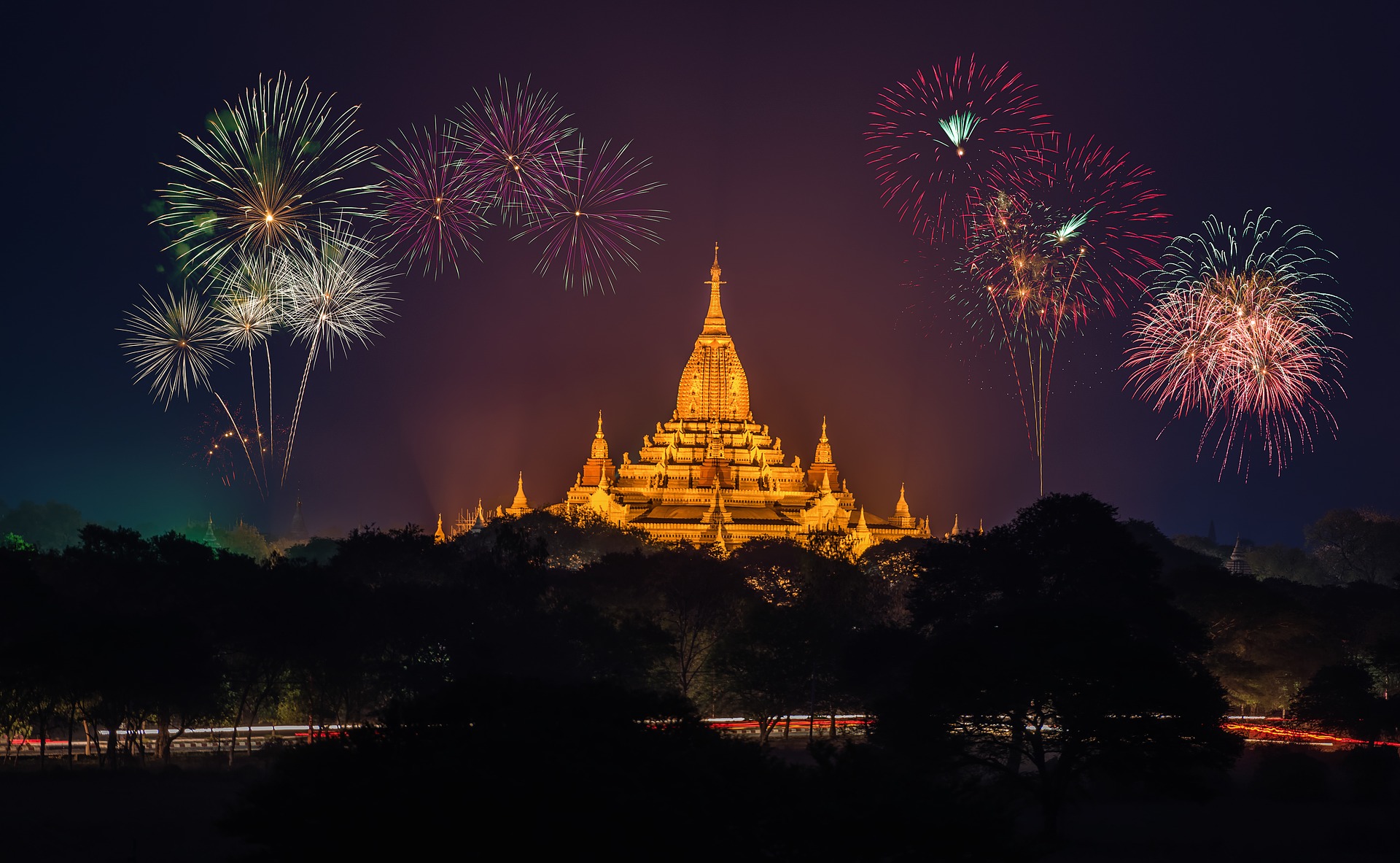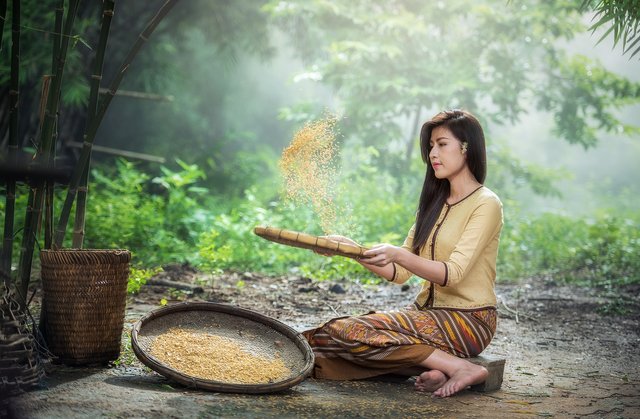Your Weekend Travel Guide : Top Attractions in Myanmar! ( Also included Extra Facts ! )
Myanmar ( Burma ) ?

Myanmar (Burmese pronunciation: [mjəmà]),officially the Republic of the Union of Myanmar and formerly known as Burma, is a sovereign state in Southeast Asia. Myanmar is bordered by India and Bangladesh to its west, Thailand and Laos to its east and People's Republic of China to its north and northeast. To its south, about one third of Myanmar's total perimeter of 5,876 km (3,651 mi) forms an uninterrupted coastline of 1,930 km (1,200 mi) along the Bay of Bengal and the Andaman Sea. The country's 2014 census counted the population to be 51 million people.As of 2017, the population is about 54 million.[10] Myanmar is 676,578 square kilometres (261,228 square miles) in size. Its capital city is Naypyidaw, and its largest city and former capital is Yangon (Rangoon).
Myanmar has been a member of the Association of Southeast Asian Nations (ASEAN) since 1997. ( Wikipedia )

Administrative divisions
Myanmar is divided into seven states (ပြည်နယ်) and seven regions (တိုင်းဒေသကြီး), formerly called divisions.Regions are predominantly Bamar (that is, mainly inhabited by the dominant ethnic group). States, in essence, are regions that are home to particular ethnic minorities. The administrative divisions are further subdivided into districts, which are further subdivided into townships, wards, and villages.

Below are the number of districts, townships, cities/towns, wards, village groups and villages in each divisions and states of Myanmar.


Culture
A diverse range of indigenous cultures exist in Myanmar, the majority culture is primarily Buddhist and Bamar. Bamar culture has been influenced by the cultures of neighbouring countries. This is manifested in its language, cuisine, music, dance and theatre. The arts, particularly literature, have historically been influenced by the local form of Theravada Buddhism. Considered the national epic of Myanmar, the Yama Zatdaw, an adaptation of India's Ramayana, has been influenced greatly by Thai, Mon, and Indian versions of the play.Buddhism is practised along with nat worship, which involves elaborate rituals to propitiate one from a pantheon of 37 nats.

In a traditional village, the monastery is the centre of cultural life. Monks are venerated and supported by the lay people. A novitiation ceremony called shinbyu is the most important coming of age events for a boy, during which he enters the monastery for a short time.[328] All male children in Buddhist families are encouraged to be a novice (beginner for Buddhism) before the age of twenty and to be a monk after the age of twenty. Girls have ear-piercing ceremonies (နားသ) at the same time. Burmese culture is most evident in villages where local festivals are held throughout the year, the most important being the pagoda festival. Many villages have a guardian nat, and superstition and taboos are commonplace.

An Arakan (Rakhine) girl pours water at revellers during the Burmese New Year Thingyan Water Festival in Yangon.
British colonial rule introduced Western elements of culture to Myanmar. Myanmar's education system is modeled after that of the United Kingdom. Colonial architectural influences are most evident in major cities such as Yangon.[330] Many ethnic minorities, particularly the Karen in the southeast and the Kachin and Chin who populate the north and northeast, practice Christianity. According to The World Factbook, the Burman population is 68% and the ethnic groups constitute 32%. However, the exiled leaders and organisations claims that ethnic population is 40%, which is implicitly contrasted with CIA report (official US report).

( ref : https://en.wikipedia.org/wiki/Myanmar )
10 Top Tourist Attractions in Myanmar
Myanmar, the official name for the Southeast Asian nation more commonly known as Burma, is a must-see for travelers who like Buddha and beaches, though not necessarily in that order. The country contains thousands of Buddhist temples. It also has pristine white beaches along the Bay of Bengal and Andaman Sea. The country is slowly opening to foreign tourism, so travelers who want to experience a more traditional Burma may want to visit now. An overview of the top tourist attractions in Myanmar:
Shwemawdaw Paya

Shwemawdaw Paya got its name, the Great Golden God, because the glittering gold that covers it can be seen for miles around. The diamond-studded top also is responsible for some of the glitter. At almost 114 meters (375 feet) high, it is the tallest pagoda in Myanmar. It is especially important to Buddhism because it contains several relics belonging to Buddha. Located in Bago, the 1,000-year-old complex is highly ornate with smaller pagodas that also are gold-covered, statues and pavilions.
Ayeyarwady River Cruise

Myanmar’s longest river, the Ayeyarwady, also known as the Irawaddy, begins high in the Himalayas, carving Myanmar in half on its way to the Andaman Sea. It is navigable by large ships and boats in the lower elevations, and is fast becoming a popular river cruise destination. Cruises run between Mandalay and Bagan; both cities offer plenty of temples, pagodas and statues of Buddha. Between the two terminals, cruisers will see river villages and beakless dolphins, and travel through jungles and deep gorges.
Shwenandaw Monastery

Shwenandaw Monastery is an historic Buddhist monastery in the city of Mandalay. Known as the Golden Palace, this important building is located in central Myanmar. It was originally part of the Mandalay Palace complex as the royal apartment of a king, but his son moved it outside the palace after his death believing it was haunted by the king’s spirit. It later became a monastery. At one time, the building was covered in gold but the gold is mostly inside now. The exterior is covered with ornate teak carvings representing Buddhist myths. Ornate carvings made from other materials such as stone can be found throughout the structure.
Ngapali

Ngapali combines two worlds in this Southeast Asian country. It is Myanmar’s premier resort town, with white sand beaches lining the blue waters of the Bay of Bengal and luxury hotels. It is a great spot to chill out and just relax. Contrast this with its fishing village atmosphere with local restaurants serving the day’s catch and ox-carts doubling as taxis. Locals believe the town is named after Napoli (Naples) in Italy. Most people visit Ngapali November to March; the rest of the year it is a sleepy little beach town.
Mrauk U

Mrauk U is an important archeological town. It was originally thought to be a fortress because of the thick walls, but the walls were made to protect temples from the fierce winds, not invaders. Stone temples can be found throughout the area. The medieval town was once an important Arakan capital and was an important trading city. Getting to this remote location involves a four- to seven-hour boat ride up a tributary of the Kaladan River. Travelers may want to bring rain gear at the region gets almost 1.2 meter (4 feet) of rain annually.
Inle Lake

Vast and serene Inle Lake is one of the top tourist attractions in Myanmar. Besides its considerable natural beauty the lake also attracts tourists for the stilt houses of the Intha, the descendants of Mon people from the far southeast. A typical day-trip on the lake, taken in a long, narrow boat with a noisy outboard motor, will stick to the northern reaches of Inle Lake. These trips also include visits to small workshops in stilt villages, several pagodas and probably a market. Travelers are also likely to see fishermen propelling their boats using a distinctive leg-rowing technique, and other Intha residents of the lake tending to fruit and vegetables on floating gardens.
Taung Kalat

Built atop an extinct volcano plug, the Buddhist monastery of Taung Kalat is one of the most breathtaking sites in Burma. To reach the monastery, visitors must climb the 777 steps to the summit. Along the way are a multitude of Macaque monkeys expecting treats. From the top of Taung Kalat, one can enjoy a panoramic view. One can see the ancient city of Bagan and the massive solitary conical peak of Mount Popa, the volcano that actually caused the creation of the volcanic plug.
Shwedagon Pagoda

The Shwedagon or Greater Dragon Pagoda is considered the most sacred site in Buddhism in Myanmar because it contains a strand of Buddha’s hair and other religious relics. The 2,500-year-old pagoda is located on Singuttara Hill in Yangon, the largest city in Myanmar. Over the centuries, the pagoda has grown from 8 meters to 99 meters (26 feet to 366 feet). The origins of Shwedagon are lost in antiquity but it is estimated that the Pagoda was first built by the Mon during the Bagan period, sometime between the 6th and 10th century AD. It is covered in gold leaf; the stupa is covered in 4,531 diamonds. Numerous temples, statues and stupas can be found at this unforgettable site. Pagoda visitors are expected to follow a dress code (trousers preferred, T-shirts with elbow-length sleeves) and enter the temple barefooted.
Golden Rock

Golden Rock, or Kyaiktiyo Zedi as it is known locally, is a totally awesome sight: a pagoda (zedi) sitting atop a huge boulder that appears as if it’s about to fall off the edge of a cliff. Both are covered in golf leaf. The locals believe the boulder, which sits 1,100 meters (3,600 feet) above sea level, is held in place through a miracle of Buddha; the pagoda is said to contain a strand of his hair. Visiting here is a pilgrimage for Myanmar Buddhists. Golden Rock is about a five-hour drive from Yangon, and also involves a long walk. A staircase leads to the pagoda complex that houses several viewing platforms and Buddha shrines.
Bagan

Travelers with a passion for Buddhist temples, pagodas and stupas should have a field day in Bagan, since it contains more of these than any other place in the world. The most popular destination in Myanmar, Bagan was the capital of the First Burmese Empire from the 9th to the 13th centuries. The site that Marco Polo once described as the “gilded city” was home to around Buddhist 13,000 temples in its 11th-century heyday. Thousands of temples, stupas and pagodas remain, including the famous Ananda temple with its sparkling gold spires.
( ref : http://www.touropia.com/tourist-attractions-in-myanmar/ )
Please kindly resteem , upvote and follow me and I will do the same to you ! :D peace!

I like your post.. have apvoted by @suhendi
Thanks dude!